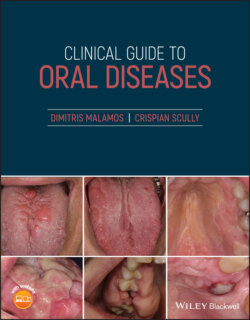Читать книгу Clinical Guide to Oral Diseases - Crispian Scully - Страница 54
Case 4.7
ОглавлениеFigure 4.7
CO: A 37‐year‐old man presented for an evaluation of his repellent odor.
HPC: His breath had a strong acetone like odor and was first perceived two months ago by his therapist who tried to help him to stop his drinking habit.
PMH: His medical history did not reveal any serious diseases or drug abuse apart from alcoholism that was diagnosed five years ago, and treated with counseling and use disulfiram (Antabuse) drug over the last two months.
OE: The oral examination revealed a neglected dentition with missing teeth, decays, and external stains as well as mature plaque and food debris on most of his remaining teeth whose gingivae were inflamed (Figure 4.7). A strong acetone‐like odor was easily noticed and remained unchanged during his examination.
Q1 Which is the main cause of his halitosis?
1 Alcohol overuse
2 Poor oral hygiene
3 Caries
4 Gingival disease
5 Drug‐induced
Answers:
1 No
2 No
3 No
4 No
5 Dusilfiram‐induced halitosis is the answer. This drug is used to stop alcoholism by inhibiting acetaldehyde dehydrogenase and inducing a hangover effect after alcohol consumption. The metabolism of this drug enhances the acetone concentration in the blood which is finally transferred to the pulmonary alveoli and excreted into exhaled air, thus producing the characteristic odor.
Comments: Halitosis induced by periodontitis has a chronic, constant fruity odor in contrast with the acetone‐like odor induced by dusilfiram, while the halitosis from poor oral hygiene, caries, and alcohol use are temporary and can disappear with brushing, restorations, and withdrawal of alcohol.
Q2 Which other drugs are responsible for unpleasant odor when are metabolized?
1 Penicillamine
2 Valsartan
3 Paraldehyde
4 Tetracyclines
5 Dimethyl sulfoxide
Answers:
1 Penicillamine is the drug of choice for rheumatoid arthritis which releases malodor components, rich in hydrogen sulfide, during its degradation. These components are responsible for rotten egg‐like halitosis.
2 No
3 Paraldehyde is used intravenously in epileptic crisis and is related to pungent odor.
4 No
5 Dimethyl sulfoxide or DMSO is an anti‐inflammatory and antioxidant drug with good results in interstitial cystitis. This drug is metabolized into dimethyl sulfide which is a stable malodor component in the blood and released into exhaled air, causing a garlic odor.
Comments: Tetracyclines are widely used antibiotics for various bacterial infections including acne, and sometimes cause a metallic taste. Valsartan is an angiotensin II blocker that is used for hypertension, causing a dry mouth but not bad breath.
Q3 Which drug components are related to garlic‐like odor?
1 Methyl mercaptan
2 Hydrogen sulfate
3 Ammonia
4 Allyl mercaptan
5 Allyl methyl sulfide
Answers:
1 No
2 No
3 No
4 Allyl mercaptan is a small molecule in the blood, which in adequate concentration in the alveolar air, can cause a garlic odor.
5 Allyl methyl sulfide is an organosulfur compound with the chemical formula CH2‐CHCH2SCH3, which releases garlic odor when it is metabolized.
Comments: Drugs containing hydrogen sulfate, methyl mercaptan or ammonia when released in the exhaled air give a characteristic odor of rotten fruit, pungent, and a pleasant odor respectively.
